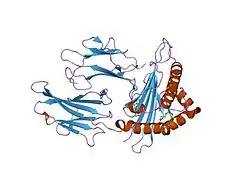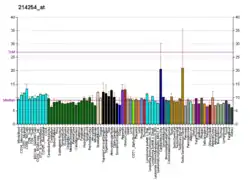MAGEA4
Melanoma-associated antigen 4 is a protein that in humans is encoded by the MAGEA4 gene.[3][4]
| MAGEA4 | |||||||||||||||||||||||||||||||||||||||||||||||||||
|---|---|---|---|---|---|---|---|---|---|---|---|---|---|---|---|---|---|---|---|---|---|---|---|---|---|---|---|---|---|---|---|---|---|---|---|---|---|---|---|---|---|---|---|---|---|---|---|---|---|---|---|
 | |||||||||||||||||||||||||||||||||||||||||||||||||||
| |||||||||||||||||||||||||||||||||||||||||||||||||||
| Identifiers | |||||||||||||||||||||||||||||||||||||||||||||||||||
| Aliases | MAGEA4, CT1.4, MAGE-41, MAGE-X2, MAGE4, MAGE4A, MAGE4B, MAGE family member A4 | ||||||||||||||||||||||||||||||||||||||||||||||||||
| External IDs | OMIM: 300175 HomoloGene: 134073 GeneCards: MAGEA4 | ||||||||||||||||||||||||||||||||||||||||||||||||||
| |||||||||||||||||||||||||||||||||||||||||||||||||||
| |||||||||||||||||||||||||||||||||||||||||||||||||||
| |||||||||||||||||||||||||||||||||||||||||||||||||||
| |||||||||||||||||||||||||||||||||||||||||||||||||||
| Wikidata | |||||||||||||||||||||||||||||||||||||||||||||||||||
| |||||||||||||||||||||||||||||||||||||||||||||||||||
This gene is a member of the MAGEA gene family. The members of this family encode proteins with 50 to 80% sequence identity to each other. The promoters and first exons of the MAGEA genes show considerable variability, suggesting that the existence of this gene family enables the same function to be expressed under different transcriptional controls.
Clinical importance
The MAGEA genes are clustered at chromosomal location Xq28. They have been implicated in some hereditary disorders, such as dyskeratosis congenita. At least four variants encoding the same protein have been found for this gene.[4]
In salivary gland carcinomas, MAGE4 expression correlates to lower-grade histology, lower likelihood of metastases and more favourable survival.[5]
While MAGEA4 is expressed by many tumours,[6] it is almost universally expressed by synovial sarcomas.[7] A targeted treatment to use genetically modified autologous T cells is (as of June 2021) undergoing clinical trials.[8]
References
- GRCh38: Ensembl release 89: ENSG00000147381 - Ensembl, May 2017
- "Human PubMed Reference:". National Center for Biotechnology Information, U.S. National Library of Medicine.
- Rogner UC, Wilke K, Steck E, Korn B, Poustka A (October 1995). "The melanoma antigen gene (MAGE) family is clustered in the chromosomal band Xq28". Genomics. 29 (3): 725–31. doi:10.1006/geno.1995.9945. PMID 8575766.
- "Entrez Gene: MAGEA4 melanoma antigen family A, 4".
- Vital D, Ikenberg K, Moch H, Roessle M, Huber GF (June 2018). "The expression of the cancer testis antigen MAGE A4: A favorable prognostic biomarker in salivary gland carcinomas related to low tumor grading". Laryngoscope Investigative Otolaryngology. 3 (3): 182–190. doi:10.1002/lio2.160. PMC 6057220. PMID 30062133.
- Yakirevich E, Sabo E, Lavie O, Mazareb S, Spagnoli GC, Resnick MB (December 2003). "Expression of the MAGE-A4 and NY-ESO-1 cancer-testis antigens in serous ovarian neoplasms". Clinical Cancer Research. 9 (17): 6453–60. PMID 14695148.
- "Specific Peptide-Enhanced Affinity Receptor MAGE-A4 T Cells for Synovial Sarcoma". www.healio.com. Retrieved 2021-07-02.
- Hong DS, Butler MO, Johnson M, Olszanski AJ, Norry E, Van Winkle E, et al. (October 2018). "Initial safety assessment of MAGE-A4 SPEAR T-cells". Annals of Oncology. 29: viii412. doi:10.1093/annonc/mdy288.029.
Further reading
- Brasseur F, Rimoldi D, Liénard D, Lethé B, Carrel S, Arienti F, et al. (November 1995). "Expression of MAGE genes in primary and metastatic cutaneous melanoma". International Journal of Cancer. 63 (3): 375–80. doi:10.1002/ijc.2910630313. PMID 7591235. S2CID 38676798.
- Imai Y, Shichijo S, Yamada A, Katayama T, Yano H, Itoh K (July 1995). "Sequence analysis of the MAGE gene family encoding human tumor-rejection antigens". Gene. 160 (2): 287–90. doi:10.1016/0378-1119(94)00680-Q. PMID 7642112.
- De Plaen E, Arden K, Traversari C, Gaforio JJ, Szikora JP, De Smet C, et al. (1994). "Structure, chromosomal localization, and expression of 12 genes of the MAGE family". Immunogenetics. 40 (5): 360–9. doi:10.1007/BF01246677. PMID 7927540. S2CID 11331427.
- Ding M, Beck RJ, Keller CJ, Fenton RG (July 1994). "Cloning and analysis of MAGE-1-related genes". Biochemical and Biophysical Research Communications. 202 (1): 549–55. doi:10.1006/bbrc.1994.1963. PMID 8037761.
- De Plaen E, Naerhuyzen B, De Smet C, Szikora JP, Boon T (March 1997). "Alternative promoters of gene MAGE4a". Genomics. 40 (2): 305–13. doi:10.1006/geno.1996.4566. PMID 9119398.
- Hillig RC, Coulie PG, Stroobant V, Saenger W, Ziegler A, Hülsmeyer M (July 2001). "High-resolution structure of HLA-A*0201 in complex with a tumour-specific antigenic peptide encoded by the MAGE-A4 gene". Journal of Molecular Biology. 310 (5): 1167–76. doi:10.1006/jmbi.2001.4816. PMID 11502003.
- Yutani S, Tanaka M, Mutsumoto H, Imai N, Sata M, Shichijo S, et al. (April 2002). "Elevation of serum MAGE-4 protein levels and prediction of hepatocellular carcinogenesis in patients with liver cirrhosis". Japanese Journal of Cancer Research. 93 (4): 453–8. doi:10.1111/j.1349-7006.2002.tb01277.x. PMC 5927013. PMID 11985796.
- Kocher T, Zheng M, Bolli M, Simon R, Forster T, Schultz-Thater E, et al. (August 2002). "Prognostic relevance of MAGE-A4 tumor antigen expression in transitional cell carcinoma of the urinary bladder: a tissue microarray study". International Journal of Cancer. 100 (6): 702–5. doi:10.1002/ijc.10540. PMID 12209610.
- Resnick MB, Sabo E, Kondratev S, Kerner H, Spagnoli GC, Yakirevich E (September 2002). "Cancer-testis antigen expression in uterine malignancies with an emphasis on carcinosarcomas and papillary serous carcinomas". International Journal of Cancer. 101 (2): 190–5. doi:10.1002/ijc.10585. PMID 12209997.
- Nagao T, Higashitsuji H, Nonoguchi K, Sakurai T, Dawson S, Mayer RJ, et al. (March 2003). "MAGE-A4 interacts with the liver oncoprotein gankyrin and suppresses its tumorigenic activity". The Journal of Biological Chemistry. 278 (12): 10668–74. doi:10.1074/jbc.M206104200. PMID 12525503.
- Sarcevic B, Spagnoli GC, Terracciano L, Schultz-Thater E, Heberer M, Gamulin M, et al. (2003). "Expression of cancer/testis tumor associated antigens in cervical squamous cell carcinoma". Oncology. 64 (4): 443–9. doi:10.1159/000070305. PMID 12759544. S2CID 578770.
- Sakurai T, Itoh K, Higashitsuji H, Nagao T, Nonoguchi K, Chiba T, Fujita J (April 2004). "A cleaved form of MAGE-A4 binds to Miz-1 and induces apoptosis in human cells". The Journal of Biological Chemistry. 279 (15): 15505–14. doi:10.1074/jbc.M310437200. hdl:2433/147540. PMID 14739298.
- Miyahara Y, Naota H, Wang L, Hiasa A, Goto M, Watanabe M, et al. (August 2005). "Determination of cellularly processed HLA-A2402-restricted novel CTL epitopes derived from two cancer germ line genes, MAGE-A4 and SAGE". Clinical Cancer Research. 11 (15): 5581–9. doi:10.1158/1078-0432.CCR-04-2585. PMID 16061876.
- Hudolin T, Juretic A, Spagnoli GC, Pasini J, Bandic D, Heberer M, et al. (January 2006). "Immunohistochemical expression of tumor antigens MAGE-A1, MAGE-A3/4, and NY-ESO-1 in cancerous and benign prostatic tissue". The Prostate. 66 (1): 13–8. doi:10.1002/pros.20312. PMID 16114059. S2CID 24732367.
- Rual JF, Venkatesan K, Hao T, Hirozane-Kishikawa T, Dricot A, Li N, et al. (October 2005). "Towards a proteome-scale map of the human protein-protein interaction network". Nature. 437 (7062): 1173–8. Bibcode:2005Natur.437.1173R. doi:10.1038/nature04209. PMID 16189514. S2CID 4427026.
- Yoshida N, Abe H, Ohkuri T, Wakita D, Sato M, Noguchi D, et al. (May 2006). "Expression of the MAGE-A4 and NY-ESO-1 cancer-testis antigens and T cell infiltration in non-small cell lung carcinoma and their prognostic significance". International Journal of Oncology. 28 (5): 1089–98. doi:10.3892/ijo.28.5.1089. PMID 16596224.
- Peikert T, Specks U, Farver C, Erzurum SC, Comhair SA (May 2006). "Melanoma antigen A4 is expressed in non-small cell lung cancers and promotes apoptosis". Cancer Research. 66 (9): 4693–700. doi:10.1158/0008-5472.CAN-05-3327. PMID 16651421.


